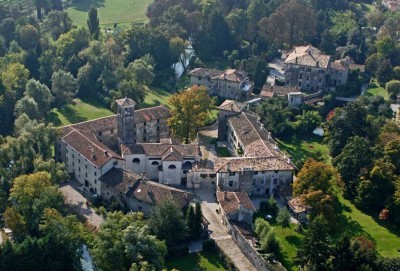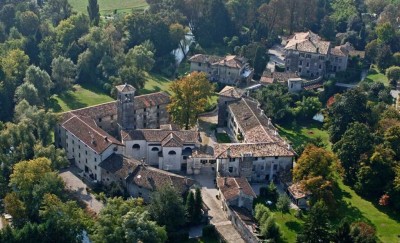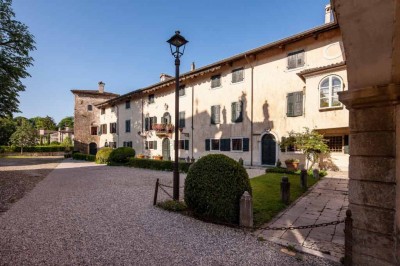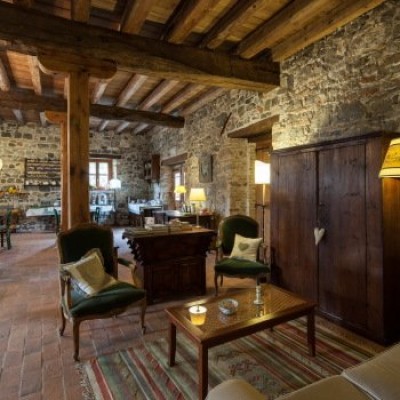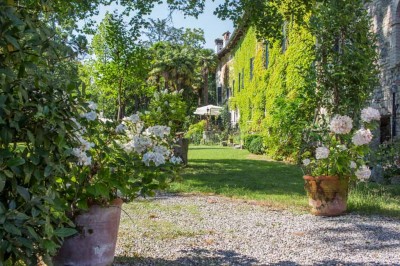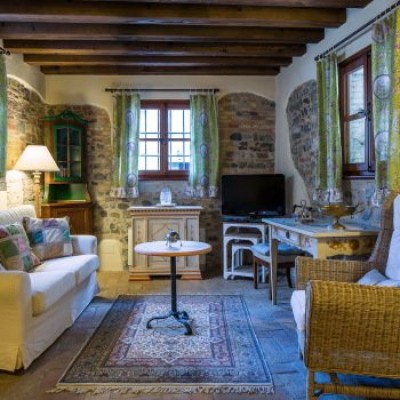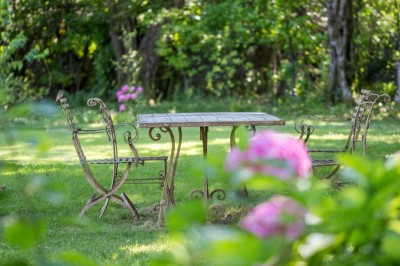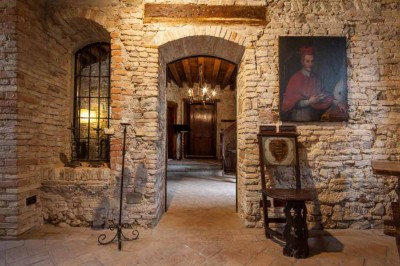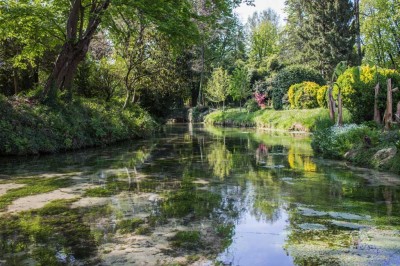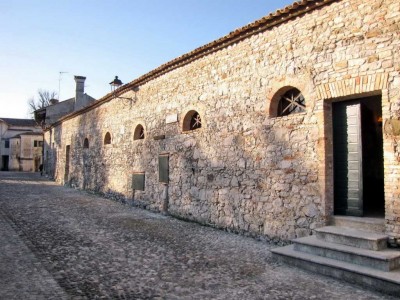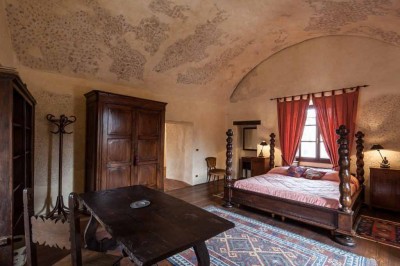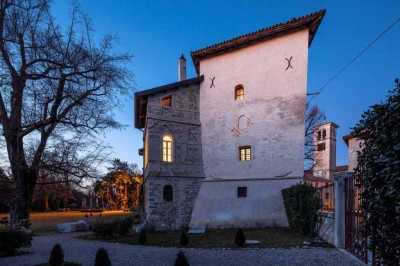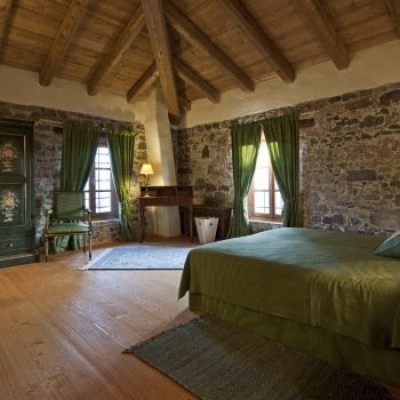Contact the abode
CASTELLO DI STRASSOLDO DI SOPRA
The original Strassoldo Castle was built more than a thousand years ago along the ancient Via Julia Augusta, the Roman road that once connected Aquileia to Norico, a historical province roughly corresponding to parts of modern Austria and Slovenia. An ancient document mentions the existence of a small fortress on this site as early as 530, and there was initially a single manor house known as "dalle due torri" (meaning ‘from the two towers’). Several centuries later, two separate castles arose, each around one of the original towers, one of which still exists and is incorporated into the central Palazzo of the Upper Castle. Each of the castle complexes consists of a main body surrounded by its own village, consisting of buildings that were once used for administrative and agricultural purposes and a park. The village developed over the centuries outside the castle walls.
The two castles were enclosed by a double wall with several gates. Some parts of the outer walls still remain today, corresponding to Porta Cisis, the gateway which leads to the complex of the Lower Castle (‘Castello di Sotto’), and Porta Cistigna, the large archway into the complex of the Upper Castle or ‘Castello di Sopra’. A portion of the inner walls also remains, namely the Gironutto and the Pusterla of the Lower Castle. After being demolished several times, the rest of the inner walls were used as foundations for various buildings, such as those located behind the Church of San Nicolò.
The Strassoldo family was thus divided into 'quelli di Sopra' (‘those from above’) and 'quelli di Sotto' (‘those from below’) and was one of the earliest families of free feudal lords to settle in this area before 1077, the year in which the temporal power of the Patriarchate of Aquileia was formalised. The Strassoldo family defended this territory on behalf of the Saxon emperors, from whom they received fiefdoms as payment. The manors were subject to a series of complex political-military events. In 1381, they were severely damaged by the militia of the Patriarch of Aquileia, Philippe d'Alençon. In 1499, they were almost overrun by Turkish raids, prompting further fortification with additional walls and towers. They were then crushed by the imperial troops in 1509, when they were assaulted by troops belonging to the League of Cambrai, which had formed between the Holy Roman Empire and the Papacy against the Republic of Venice.
In the mid-18th century, both Strassoldo castles underwent significant restoration work which was carried out by brothers Nicolò (for the Lower Castle) and Giuseppe (for the Upper Castle), resulting in the current configuration. The twin castles of Strassoldo are a suggestive example of a fortified complex transformed into two stately residences, steeped in history and immersed in the peace and tranquillity of centuries-old parks, lapped by two resurgent rivers.
EXTERNAL DEVELOPMENT OF THE UPPER CASTLE
The complex of the Upper Castle begins with the grand arch of the ancient Cistigna Gate, located on the outer walls, which leads to the cobbled street of the Old Village or Borgo Vecchio. On the left, there is a medieval wall that marks the boundary of a grassy area used for parking, while on the right are a series of ancient stone buildings forming a linear ensemble. The lower ones were used as Houses of the Armigers, for those having the right to bear a coat of arms or heraldic insignia, while higher up was the Vicinìa, an ancient administrative centre which, for a certain period of time was also used as a tribunal for minor cases.
The Upper Castle of Strassoldo and its Old Village developed around the ancient Ottonian tower. Proceeding southwards, you arrive at the Coretto, a low arched passage with windows that connects the main castle building to the Church of St. Nicholas. The latter was the private church of the Upper Manor. As the original church in the village (Santa Maria in Vineis) had become too small for the population by the end of the 18th century, the ancestors of the current owner enlarged their own chapel, changing the direction of the apse, embellishing it and opening it up to the whole village, at the same time donating 60 fields and the widows' house, which became the rectory. The property only passed to the church in 1938.
It should be noted, in the interest of raising awareness that respecting historical heritage is essential in a civilised society due to its high social and cultural value and its positive impact on the economy, if valorised properly, that the roof and external walls of the Church of St. Nicholas were finally restored in 2020. Unfortunately, the interiors were badly deteriorated and showed significant signs of neglect. The antique 18th-century pews, the pulpit and many furnishings disappeared at some point in the proceedings, indubitably ending up in the hands of an antique dealer. Some pictorial sections had been partially painted over, and the presbytery was sadly disfigured both internally and externally due to interventions commissioned by incompetent parties.
The Coretto leads to the main square, where the Church of St. Nicholas (satisfactorily rotated during the significant restoration work completed in the 18th century) is situated, facing the main façade of the Castle. The square features a gravel area, a parterre of box hedges, ivy and lawn, a series of stone columns, large terracotta vases filled with flowers, an ancient stone pavement and beautiful white stone benches. The main building is supported by the Ottonian tower, which was lowered by two floors for structural reasons in the mid-19th century, following a powerful earthquake whose epicentre was in Ljubljana, and the effects of which were also felt in Strassoldo.
The castle park extends out to the rear of the main building. Buildings that were once used as stables, the craftsmen's houses, the granaries and the chancellery stand in a semicircle arrangement on the remains of the inner castle wall at the back of the St. Nicholas’ Church. Behind the chancellery, the extensive green area of the Brolo (an ancient orchard and vegetable garden), now transformed into a charming garden, stretches toward the Taglio river. It is surrounded by water and contains a lovely circular stone fountain, a fruit-bearing orchard garden, roses of various species, shrubs and trees, with steps leading down to the water. Moving further south, you then reach the ‘Pileria del riso’ rice mill and, immediately afterwards, the bridge over the Pileria canal, which enters the area of the Lower Castle. The layout of the latter resembles that of the Upper Castle, in that it consists of a main body behind which an extensive park and countryside extend, along with houses that once served agricultural and administrative purposes. Both castles still belong to the Strassoldo-Graffemberg family, although the blood relationship between the current owners is now distant.
INTERNAL DEVELOPMENT OF THE UPPER CASTLE
The main building of the Upper Castle is made up of numerous rooms full of memories, given that the family’s history here has never been interrupted. On the ground floor, there is a typical Friulian kitchen with a chequered floor, a hearth, a bread oven, a smokehouse for food preservation, and a stone sink. Next to it is the entrance hall, which opens onto the vast terrace of the garden and the viceroy's sitting room. Further on, there is the guard room and the vaulted cellar situated on the ground floor of the tower. To access the ‘piano nobile’ floor, a solemn stone staircase leads you to the Emperor's Hall on one side, so named for the portraits of Roman emperors adorning the walls, while on the other side are the Coat of Arms Room, the Stove Room and the Governor's Hall. Elegantly furnished and heated by fireplaces and ancient stoves, the rooms are decidedly atmospheric, with exquisite wooden floors and ceilings, and partly frescoed walls, displaying ancient paintings, including an extended family tree. Recent investigations have revealed that all the walls of this noble floor bear 17th-century frescoes, preserved under layers of 19th and 20th-century paint.
EVENTS AT THE CASTLE
It is possible to rent:
- The main building of Strassoldo di Sopra Castle and its centuries-old park for refined and enchanting private events.
- The chancellery of the castle with its garden, for more informal events.
At the heart of an ancient medieval village, the Castle is surrounded by centuries-old gardens, crossed by crystal-clear spring water streams. History has never been interrupted here, and the residence has always been inhabited by the same family that built it over a thousand years ago, the Imperial Counts of Strassoldo, giving the property a unique charm. The main body of the Castle is furnished with antique furniture and ancestral portraits. On the ground floor, there is a beautiful old kitchen, with an entrance hall giving access to the centuries-old park, the viceroy's lounge and the guard room. On the first floor, you will find the Emperor's hall, the Coat of Arms Room, the Room of Mirrors and the Governor's Hall. The park is meticulously maintained and personally tended by the owner. The focal point of the garden is an ancient orangery, Baroque elements such as wells, secular trees, rare plants and old English roses.
Among the various buildings in the hamlet of Sopra Castle is the ancient chancellery, where the official deed confirming the construction of the nearby fortress of Palmanova was signed in 1593. It consists of three large communicating rooms arranged in line to create a sense of visual continuity with a colourful terracotta floor, and it has a beautiful garden surrounded by spring water streams. Being more rural than the main body of the castle, it is suitable for weddings with a more informal flavour.
HOLIDAY HOMES
Strassoldo di Sopra Castle also provides 5 self-catering holiday homes, which are located within the Castle’s hamlet. Each has its own private garden and access to the main park.
CASA RAMBALDO (for a maximum of four people, accommodation on the same floor)
- Double bedroom with direct access to the garden
- Bathroom with spacious blue mosaic shower
- Equipped kitchen with dining area
- Living room with satellite TV, mezzanine loft with a double bed
- Private fenced garden with wooden table and chairs, sun loungers and barbeque.
CASA ARTUICO (for 2 people, with the possibility of using the sofa bed for a third person, accommodation on the same floor)
- Double bedroom with direct access to the garden
- Bathroom with spacious green mosaic shower, toilet, sink, washing machine
- Kitchen-dining area with garden access
- Sitting area with a sofa bed
- Private fenced garden with wooden table and chairs, sun loungers and barbeque.
CASA LA VICINIA (for 4 people, with the possibility of adding an extra bed. Spread over two floors)
Ground floor:
- Equipped kitchen, large living and dining area
- Arched porch with wooden table and chairs
- Separate enclosed garden with barbeque and a round table with chairs.
First floor:
- Double bedroom with bathroom with shower + spacious open-plan sleeping area with a double bed and bathroom with shower.
PILERIA DEL RISO (for 8 people, with the possibility of adding two extra beds. Spread over two floors)
Ground floor:
- Entrance, equipped kitchen, toilet
- Large living room/dining area with access to the Castle's fenced park, where there is a private area with tables, chairs, sun loungers and barbeque.
First floor:
- 4 spacious double bedrooms with king-size beds. Each room has its own private bathroom with a whirlpool bathtub.
TORRE OTTONIANA (for 4 people, with the possibility of adding two extra beds. Spread over three floors)
Ground floor:
- Entrance/dining room with direct access to the castle's fenced park, where there is a private area with tables, chairs, sun loungers, and barbeque
- Fully equipped kitchen and toilet.
First floor:
- Entrance hall, suite with spacious bedroom with king-size double bed
- Lounge with terrace overlooking the park
- Bathroom with large shower.
Second floor:
- Entrance, suite with spacious bedroom with king-size double bed
- Living room
- Bathroom with Devon&Devon bathtub.
